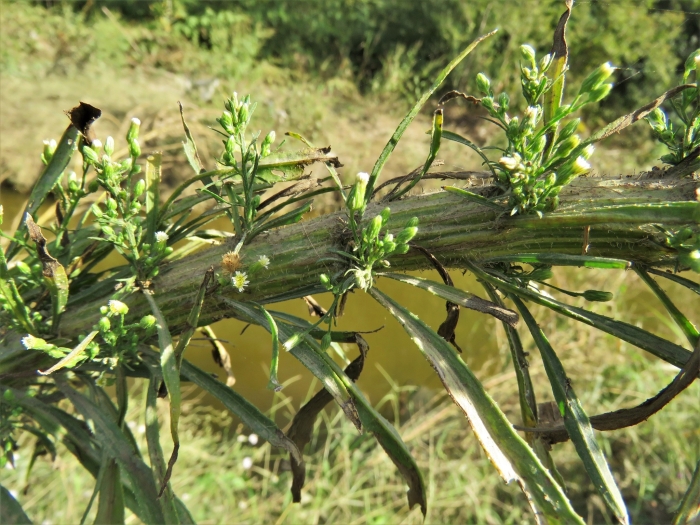Horseweed
(Erigeron canadensis)
Horseweed (Erigeron canadensis)
/
/

Annika Lindqvist
CC BY 4.0
Image By:
Annika Lindqvist
Recorded By:
Copyright:
CC BY 4.0
Copyright Notice:
Photo by: Annika Lindqvist | License Type: CC BY 4.0 | License URL: http://creativecommons.org/licenses/by/4.0/ | Rights Holder: Annika Lindqvist | Publisher: iNaturalist | Date Created: 2018-10-04T16:16:16-07:00 |
























Estimated Native Range
Summary
Erigeron canadensis, commonly known as horseweed or Canadian fleabane, is an annual herb native to open fields, roadsides, and disturbed areas throughout North America and Central America, now also naturalized in Eurasia and Australia. It typically grows up to 5 feet tall and has a slender, erect stem with sparse foliage. The leaves are narrow, lance-shaped, and may have toothed edges. From mid-summer to fall, it produces numerous small flower heads with white or pale purple ray florets surrounding a yellow center. The flowers are not particularly showy but can add a delicate texture to the landscape.
Horseweed is valued for its adaptability to a wide range of conditions and its use in erosion control due to its fast growth. It is often found in urban wastelands and can be used for naturalized or wildflower gardens, although it is not typically cultivated for ornamental purposes. It thrives in full sun to part shade and prefers well-drained soils but can tolerate poor, compacted, and dry soils. Horseweed requires minimal water once established and can be a useful plant for xeriscaping. However, it can become weedy and invasive, spreading rapidly by wind-dispersed seeds, and may outcompete other plants in the garden.CC BY-SA 4.0
Horseweed is valued for its adaptability to a wide range of conditions and its use in erosion control due to its fast growth. It is often found in urban wastelands and can be used for naturalized or wildflower gardens, although it is not typically cultivated for ornamental purposes. It thrives in full sun to part shade and prefers well-drained soils but can tolerate poor, compacted, and dry soils. Horseweed requires minimal water once established and can be a useful plant for xeriscaping. However, it can become weedy and invasive, spreading rapidly by wind-dispersed seeds, and may outcompete other plants in the garden.CC BY-SA 4.0
Plant Description
- Plant Type: Herb
- Height: 0.5-7 feet
- Width: 0.5-2 feet
- Growth Rate: Moderate
- Flower Color: Brown, Cream
- Flowering Season: Fall
- Leaf Retention:
Growth Requirements
- Sun: Full Sun
- Water: Low
- Drainage: Medium, Fast
Common Uses
Bird Garden, Erosion Control, Low Maintenance
Natural Habitat
Open fields, roadsides, and disturbed areas throughout North America and Central America
Other Names
Common Names: Horseweed, Colt’s Tail, Butterweed, Canada Fleabane, Canadian Fleabane, Canadian Horseweed, Hogweed, Mil Hojas
Scientific Names: , Erigeron canadensis, Aster canadensis, Caenotus canadensis, Caenotus pusillus, Conyza bonariensis var. angustifolia, Conyza canadensis, Conyza canadensis subsp. canadensis, Conyza canadensis var. canadensis, Conyza canadensis var. glabrata
GBIF Accepted Name: